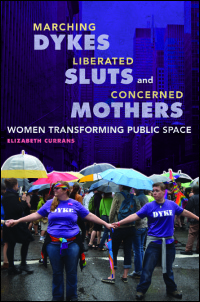New book by UO Folklore Program graduate Elizabeth Currans!

Marching Dykes, Liberated Sluts, and Concerned Mothers: Women Activists Transform Public Space (University of Illinois Press, 2017)
From the Women in Black vigils and Dyke marches to the Million Mom March, women have seized a dynamic role in early twenty-first century protest. The varied demonstrations–whether about gender, sexuality, war, or other issues–share significant characteristics as space-claiming performances in and of themselves beyond their place in any broader movement.
Elizabeth Currans blends feminist, queer, and critical race theory with performance studies, political theory, and geography to explore the outcomes and cultural relevance of public protest. Drawing on observation, interviews, and archival and published sources, Currans shows why and how women utilize public protest as a method of participating in contemporary political and cultural dialogues. She also examines how groups treat public space as an important resource and explains the tactics different women protesters use to claim, transform, and hold it. The result is a passionate and pertinent argument that women-organized demonstrations can offer scholars a path to study the relationship of gender and public space in today’s political culture.
Link: http://go.illinois.edu/f17currans
Elizabeth Currans is associate professor of Women’s and Gender Studies at Eastern Michigan University where she teaches courses in feminist, queer, performance, and disability studies. She earned her MA in Folklore Studies in 1999 from the University of Oregon and her PhD in Religious Studies and Women’s Studies in 2007 from UC Santa Barbara. Recent publications appear in Feminist Formations, Social Justice, Women’s Studies Quarterly, Obsidian, and Frontiers: A Journal of Women’s Studies. Her new research project examines public performances (bicycle rides, protests, music festivals, performance art, sculpture) in edge spaces, places were the urban and natural encounter each other.